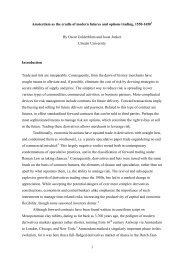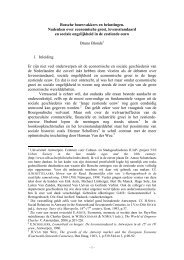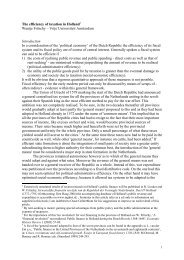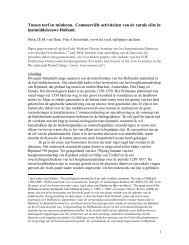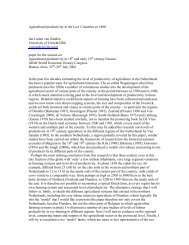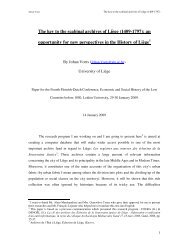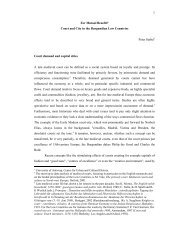Justyna Wubs-Mrozewicz LOOKING TWICE - Economy and Society ...
Justyna Wubs-Mrozewicz LOOKING TWICE - Economy and Society ...
Justyna Wubs-Mrozewicz LOOKING TWICE - Economy and Society ...
Create successful ePaper yourself
Turn your PDF publications into a flip-book with our unique Google optimized e-Paper software.
Looking twice, <strong>Justyna</strong> <strong>Wubs</strong>-<strong>Mrozewicz</strong> January 2009<br />
problem. 111 This concerned Amsterdammers, but it could have referred to all Holl<strong>and</strong>ers in<br />
Bergen. Possibly, only urgent or minor issues were addressed this way in person; more<br />
serious problems were probably dealt with by the Amsterdam aldermen, whether they<br />
travelled to Bergen or not. This appears from the fact that in writing, the Amsterdam traders<br />
in Bergen did not address the king or the Kontor directly on behalf of their group; instead<br />
their letters are signed by the aldermen or guild in Amsterdam or the council of Amsterdam.<br />
Apparently, the Amsterdam traders had difficulties in countering Hanseatic <strong>and</strong> Norwegian<br />
opposition. In 1561, the aldermen of the guild in Amsterdam decided that only experienced<br />
merchants were allowed to trade in Bergen, in order to put an end to inefficient negotiations<br />
<strong>and</strong> business conducted there. 112 It indicates that in administrative terms, Holl<strong>and</strong>ers were far<br />
less successful than Hansards in Bergen.<br />
Also in terms of settlement <strong>and</strong> numbers of traders, Hansards were clearly more<br />
prominent in Bergen. It has been assumed that the first winter residents from the northern<br />
German towns stayed in Bergen in the 1260s. 113 They concentrated their business <strong>and</strong> living<br />
quarters in the tenements (blocks of houses) at Bryggen, a part of Bergen which eventually<br />
became synonymous with the Hanseatic Kontor. 114 Still, the Kontor was not a topographically<br />
closed entity <strong>and</strong> some Hanseatic traders also occupied houses <strong>and</strong> tenements elsewhere in<br />
Bergen. 115 In this respect, the Kontor in Bergen was less segregated from the rest of the town<br />
than the Kontor in Novgorod or London, but less integrated than the Kontor in Bruges. 116 The<br />
Hanseatic merchants (as well as craftsmen <strong>and</strong> sailors’ constituted a very visible group in<br />
Bergen. Hansards occupied c. 19-31 tenements, which in turn consisted of up to twenty<br />
houses. 117 It has been calculated that in the winter the number of residents reached 1000-1500,<br />
111<br />
H<strong>and</strong>vesten, vol. 3 pp.1187-1188 § VII.<br />
112<br />
MA Amsterdam, nr. 5025, Vroedschap 1536-1795, fol. 225-226; Van Dillen, Bronnen, nr. 470.<br />
113<br />
Schreiner, Hanseatene og Norges nedgang, p. 23; Helle, Bergen I, p. 380; DN 1 nr. 122 (1309, winter<br />
residence fifty years earlier mentioned).<br />
114<br />
Helle, Bergen I, pp. 726-728. There are many sources where Hansards are identified as residents of Bryggen,<br />
for instance 1442, NGL II/1 nr. 393; 1444, NGL II/1 nr. 130 § 28 (DN 8 nr. 324); 1556, DN 22 nr. 483.<br />
115<br />
Ersl<strong>and</strong>, ‘Was the Kontor’, pp. 51-57; <strong>Wubs</strong>-<strong>Mrozewicz</strong>, Traders, Ties <strong>and</strong> Tensions, pp. 109-111.<br />
116<br />
<strong>Wubs</strong>-<strong>Mrozewicz</strong>, Traders, Ties <strong>and</strong> Tensions, pp. 111-113; Rybina, ‘Die hansischen Kaufleute in<br />
Novgorod’, p. 242; Jörn, ‘With money <strong>and</strong> bloode’, pp. 417-432; Henn, ‘Das Brügger Kontor’, pp. 219-223.<br />
117<br />
In Bryggen, the number of tenements fluctuated over time. Helle estimated the number of certain or probable<br />
Bryggen tenements in the first half of the fourteenth century at thirty-one, <strong>and</strong> after the fire of 1527 at between<br />
nineteen <strong>and</strong> twenty. Helle, Bergen I, pp. 231, 246, 710; compare Ersl<strong>and</strong>, ‘Was the Kontor’, p. 50. However,<br />
this did not necessarily mean a proportional reduction of living <strong>and</strong> working space: even though some of the<br />
burnt tenements were not rebuilt, others were exp<strong>and</strong>ed in size; see Helle, Bergen I, p. 710.<br />
16



